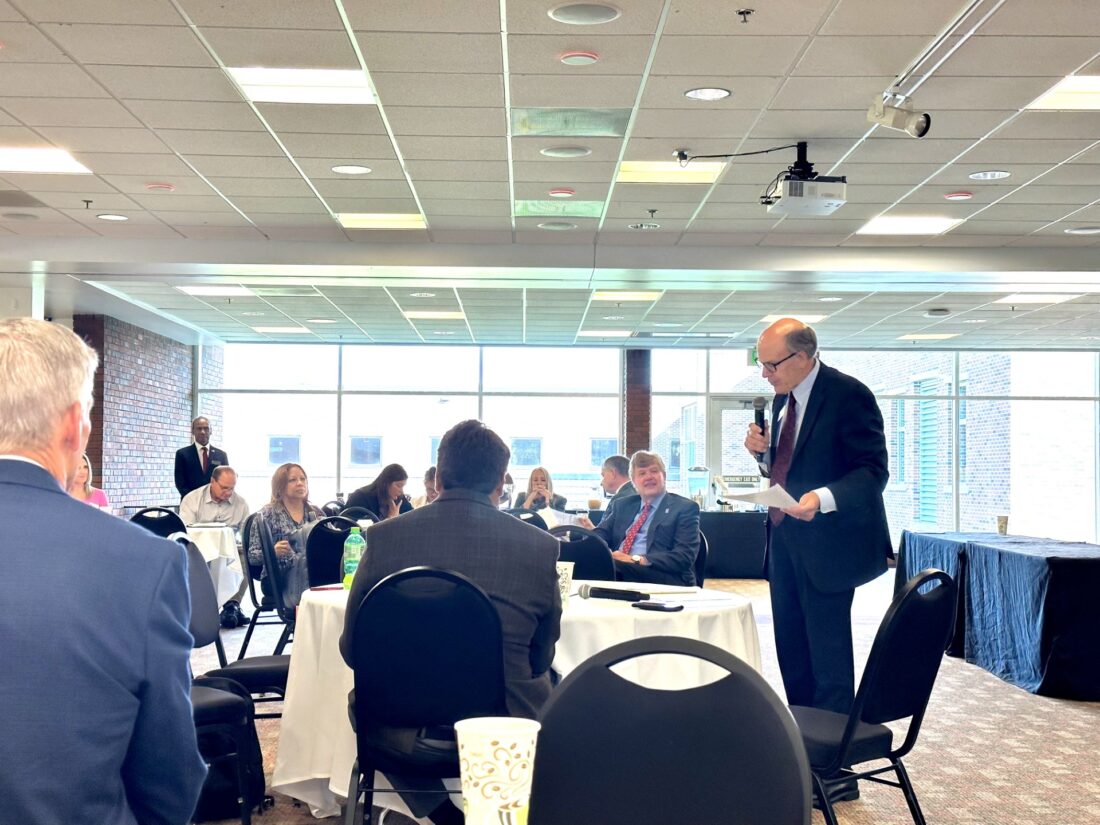SMSU sees largest enrollment increase in 14 years
“There's great things happening here.”

Photo by Samantha Davis. Chair of the Minnesota Board of Trustees George Soule talks to faculty and community members following the Minnesota State college and university meeting Wednesday morning at SMSU’s conference center.
MARSHALL — Southwest Minnesota State University saw a significant increase in fall enrollment numbers and is the fastest growing four-year institution in the state system.
“I must thank faculty, staff and administrators for their dedication to SMSU and hard work,” SMSU President Kumara Jayasuriya said Wednesday morning. “Because of you, our fall enrollment is the highest it has been in 14 years … SMSU is a main driver of this region’s economy. We provide skilled workers to many of the businesses in this area.”
SMSU hosted leaders of Minnesota State in an active listening session Wednesday morning in the campus’ conference center, where faculty and community members voiced priorities and concerns to the state Chancellor and Board of Trustees, in preparation of presenting a proposal of collective ideas from various Minnesota colleges to legislation this November for the 2026-27 fiscal year state biennial budget request.
Across the board for Minnesota universities, there has been a steady decline in enrollment numbers, until this year.
“There had been about a 10-year decline on almost every one of our campuses,” Chancellor of Minnesota State Colleges and Universities Scott Olson said. “A steady decline over 10 years in enrollment, and not just Southwest, but to see 31 of our 33 colleges and universities have an enrollment increase [is positive], and Southwest was really significant.”
Among the topics discussed was SMSU’s impressive enrollment increase, and what this can mean in regard to tuition and financial stability.
According to SMSU in a report released Tuesday, the undergraduate student retention increased to 73.4%, contributing to the overall growth and marking the fastest growing four-year university across Minnesota. The total headcount is 2,907 students for fall 2024, up 14.9% from last year.
“Look at all that this college, this university, means to this region. Your enrollment this fall is outstanding,” Olson said. “I can’t think of a better vote of confidence in what this campus does for its students, and for this whole region around Marshall. It’s really a remarkable thing.”
There are 879 new students, including first-years, transfers and graduate students, which is a 23.3% spike over the past year. The university’s full-year equivalent is up 12.5% overall, compared to fall 2023.
Students moving into dorms this fall saw a near 10% increase as well, and 388 new first-year students, which is 5.4% higher than last fall.
“It just helps to have more enrollment, because there’s more revenue to fund the programs. We want our students to have a diversity of programs available to them,” Chair of the Board of Trustees George Soule said. “Generally, when there’s more students, there’s more revenue to fund those programs. I think it just makes everyone more optimistic and favorable about our state colleges and universities. Reminds them what a great asset we have.”
A topic discussed by community members at the meeting was the idea of keeping tuition affordable, to keep SMSU as a viable option for prospect students. There was a tuition freeze for the state for the 2024-25 school year, meaning there was no increase in tuition this school year.
“I think, because of the North Star Promise and because of the tuition freeze, those [factors] are not unrelated to the statewide 7% increase in enrollment that we have seen in our system. Southwest did a little better than that [14.9%], but statewide, we’re up 7% and that’s related to affordability,” Olson said. “The average tuition increase for Minnesota state colleges and universities over the last 10 years … was 1.7%. Inflation over that same time averaged 3.2%, so our tuition was going up at a rate lower than inflation … We are working hard at affordability, and we need to keep doing it.”
North Star Promise provides free college tuition for Minnesota residents who make below $80,000 a year. This is an ongoing program and applies to all Minnesota colleges and universities.
Lori Wynia, SMSU director of online learning, reaffirmed thoughts that tuition is a big factor in attempting to keep enrollment high and combating online schools, knowing there is a balance between affordability and needing revenue income.
“The issue of tuition, I do think we need to try to keep that as low as we can,” Wynia said. “Online [school] is very popular, and they [students] are going to universities outside Minnesota … The more we build our tuition up, the more we’re going to be losing students in the undergraduate, and particularly the graduate level as well.”
Soule, who will be head in approving and presenting the budget request to Minnesota Management and Budget [MMB] legislation, understands the weight tuition costs continue to play on prospective students.
“The con [of raised tuition] is the students have to come up with more money. But, we also have a lot of scholarship programs to help support those who can’t afford it,” Soule said. “We very reluctantly raise tuition when we do it as a system, as a Board of Trustees, because we understand the burdens on the students. But, we do need the revenue to support the programs that the students want to take.”
The substantial increase in enrollment will, in hopes, continue as an upward trend for the university, which down the line, can also advance financial awareness and reputation as well.
“What that means for them [SMSU] is a little more financial stability. They have the capacity to serve these students well,” Olson said. “What it means reputationally, is students wouldn’t come here if they didn’t see good things happening. There’s great things happening here, and students want to be a part of it. That’s super exciting.”


